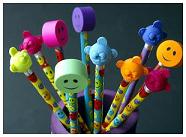
Then I tried the whole “big letter, little letter” approach, but that didn’t work, either. The letters were nearly the same size—what do you mean, this one’s a big letter and that one’s a little letter?
After a lot of mulling it over, trying to come up with a way of explaining it that would make sense to her, I said, “This one is the Mommy A, and this one is the Baby A.“ Her face lit up. She finally understood.
Mothers and children were a concept she understood. She knew they went together, but they looked different. They belonged to the same family, so they made the same sounds when you read them, even though they weren’t identical. From that moment on, teaching her about capitalization became easy as I referred to mommy letters and baby letters.
I’ve heard some parents refer to the capital letters as “special” letters, and that works too—as long as the child knows that a capital A and a lowercase A are both As and they don’t say different things just because one of them is “special.”
In some cases, you might want to wait a little bit before worrying about capitalization. Some children will grasp the concept sooner than others, and vice versa. The most important thing to start is to get them familiar with the letters and what they say. You can worry about the capitals later.
One thing I do really encourage, though, is to use only lowercase letters when you first start teaching them. We use lowercase letters much, much more of the time—just look at this sentence. There are over fifty lowercase letters to only one capital—and yet we often see workbooks and charts teaching the capital letters first. No wonder we so often see children putting capital letters out in the middle of words—they’re the first letters they learn. If you start with the lowercase letters, and then teach the capitals to be used on special occasions, you’ll find much greater success.
Related Blogs:
What Reading Skills Should Your First Grade Child Learn?
When the Kids Realize It’s Important
Match Teaching and Learning Styles

